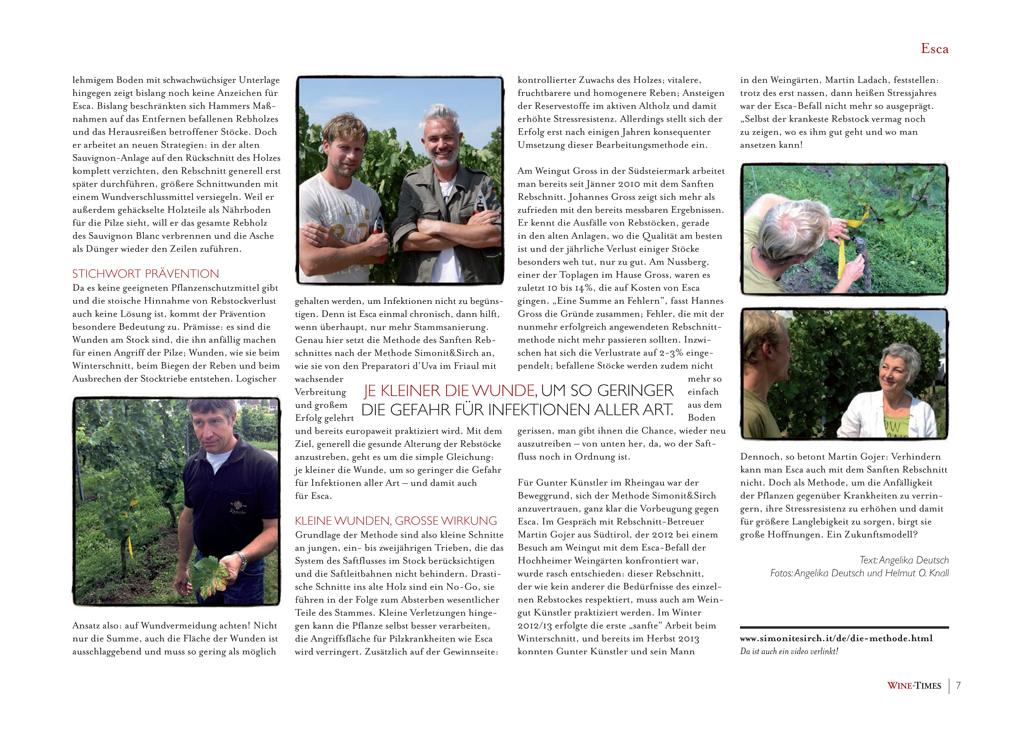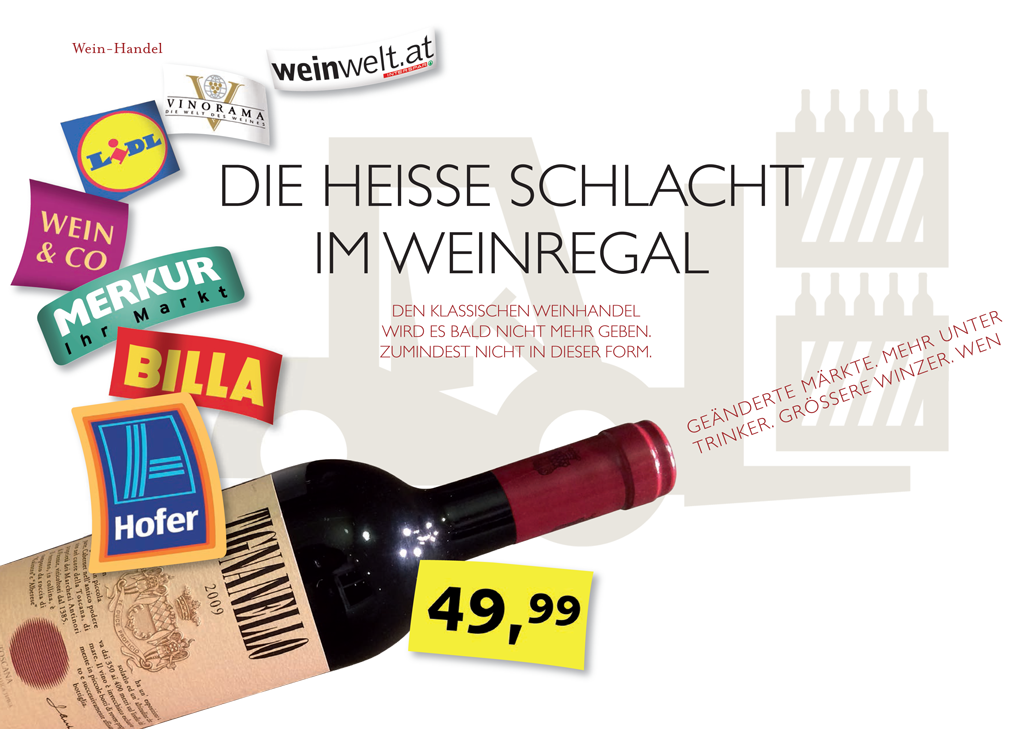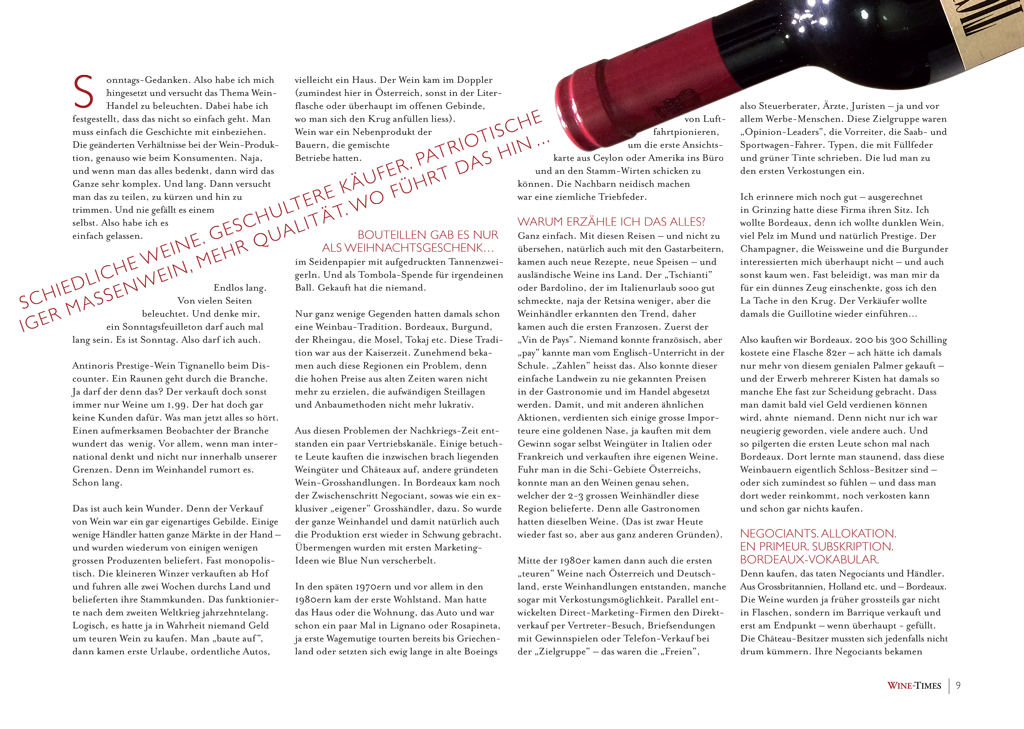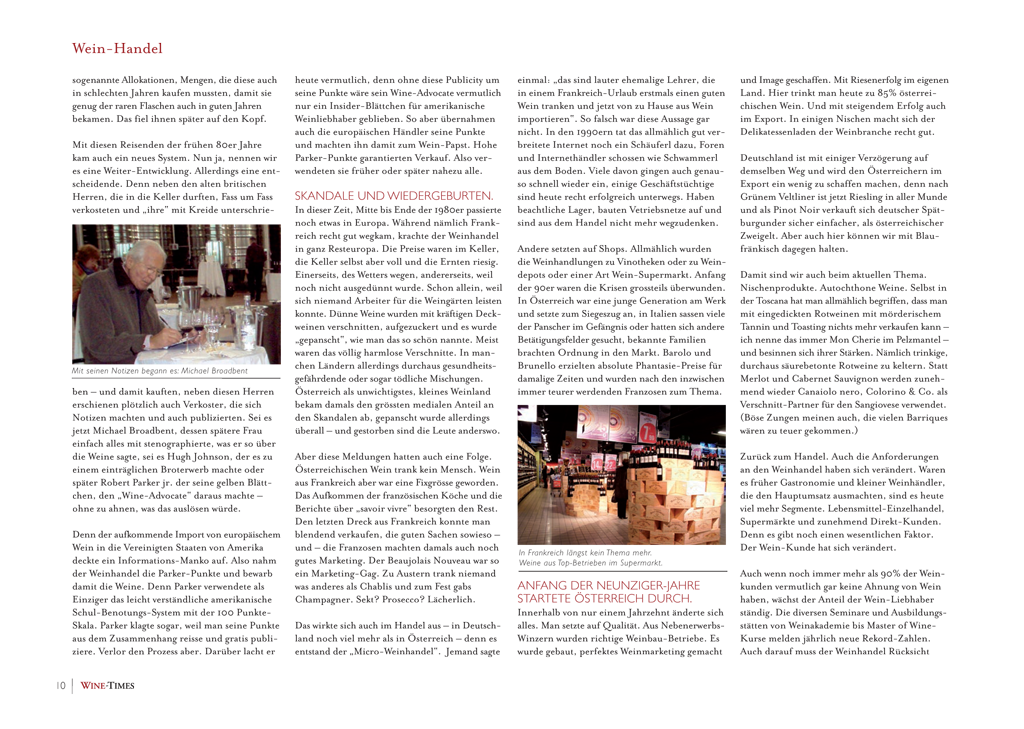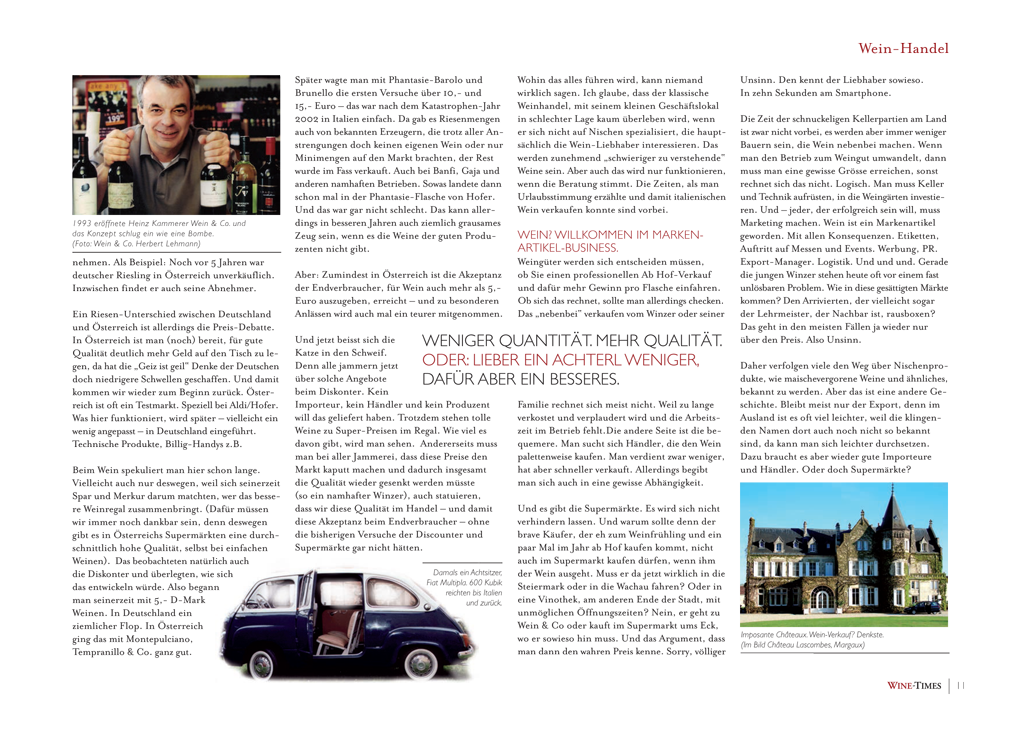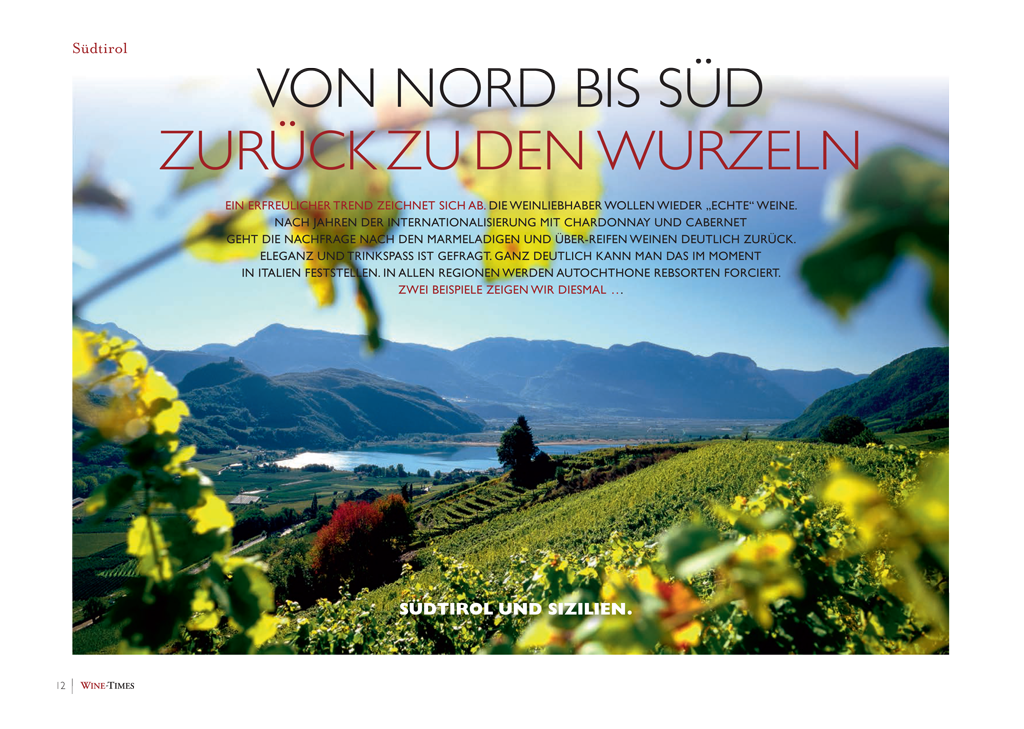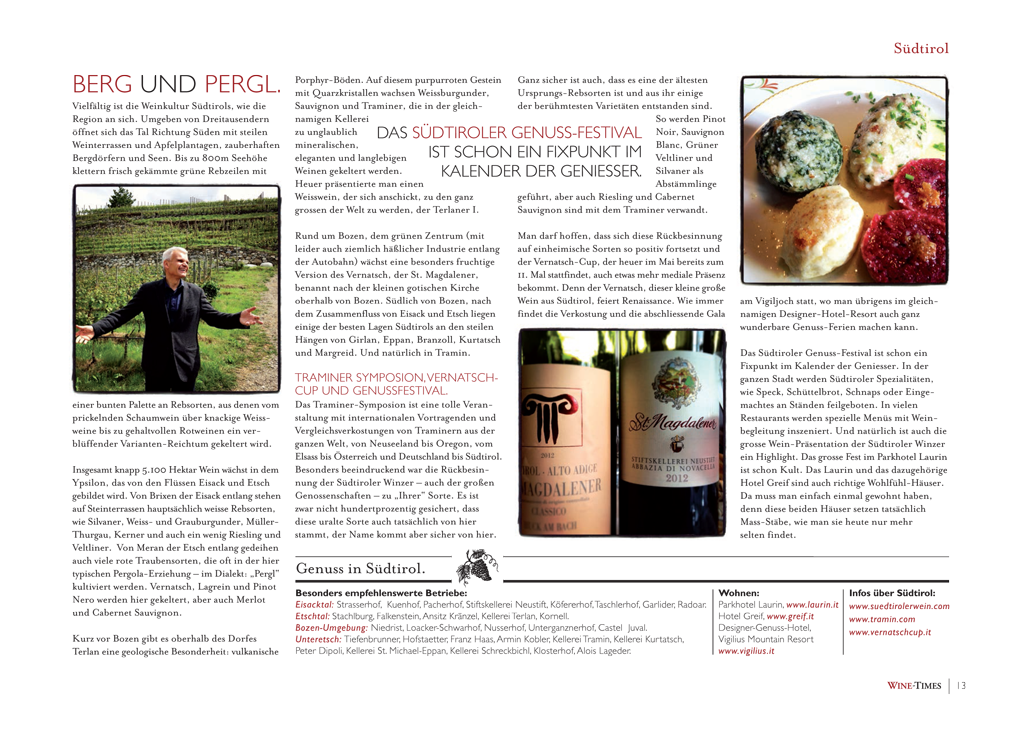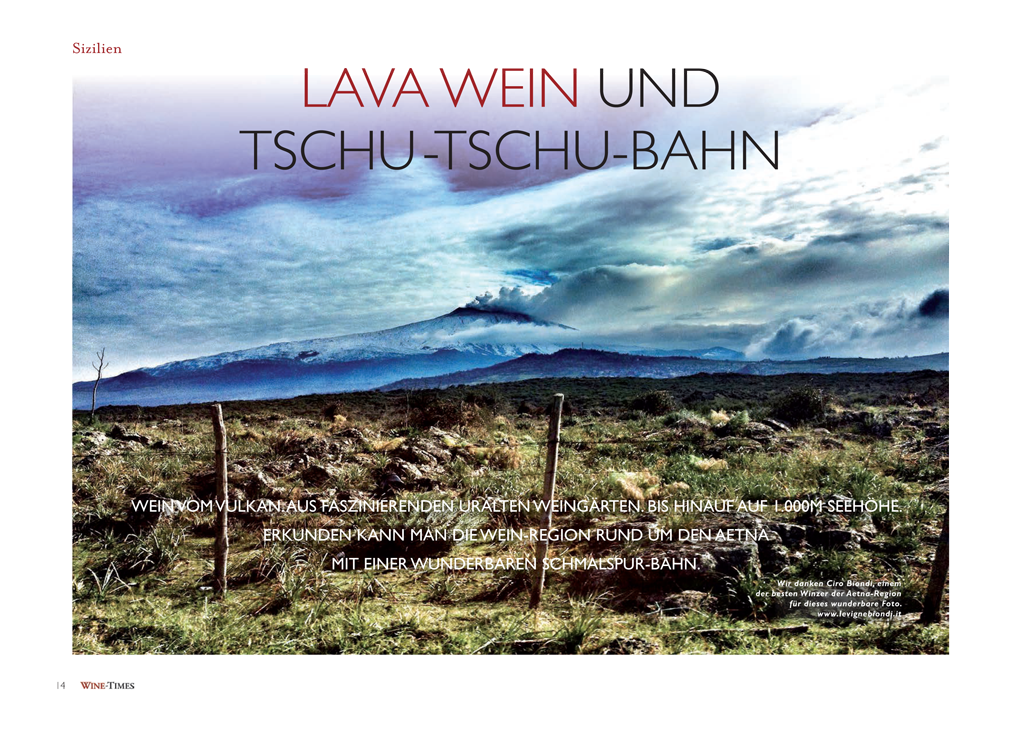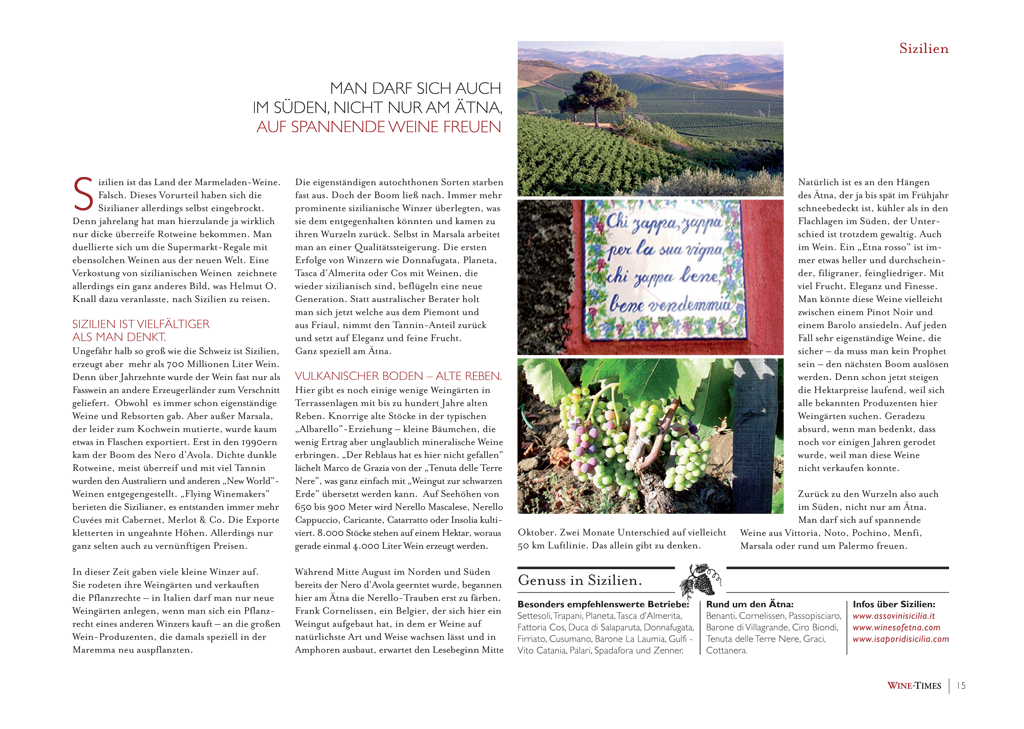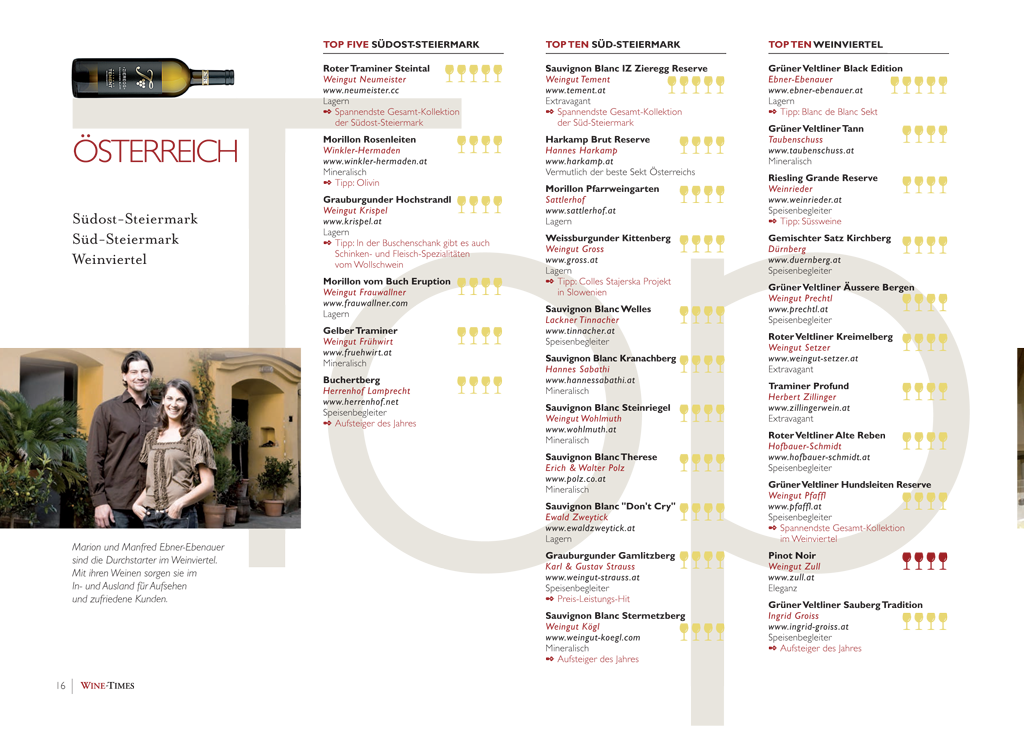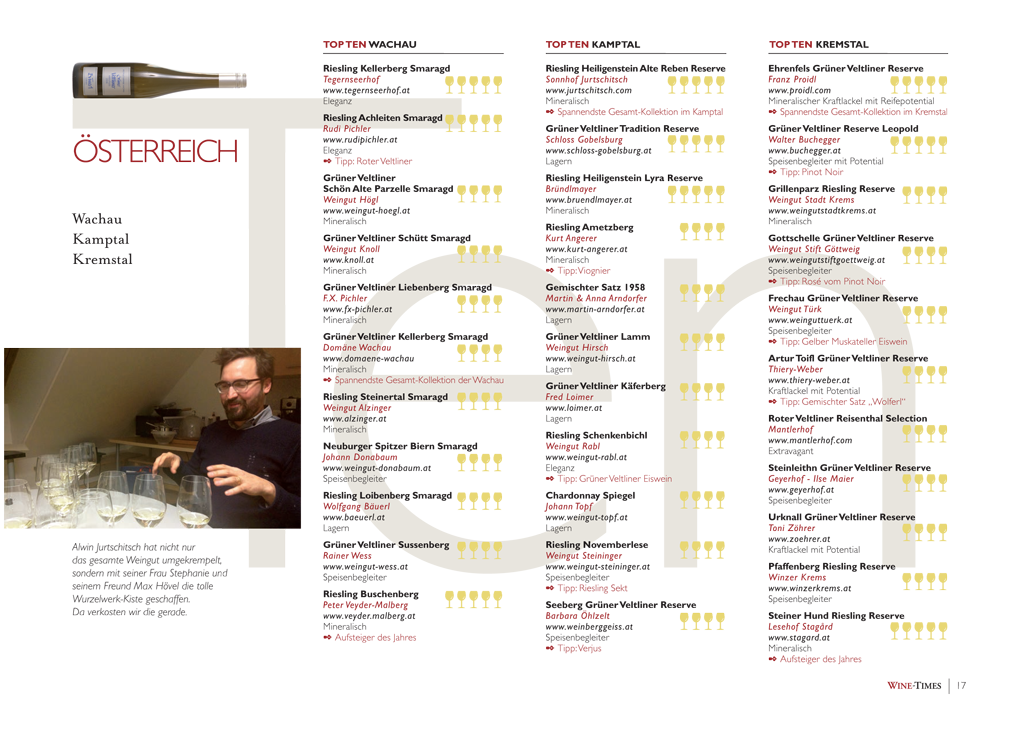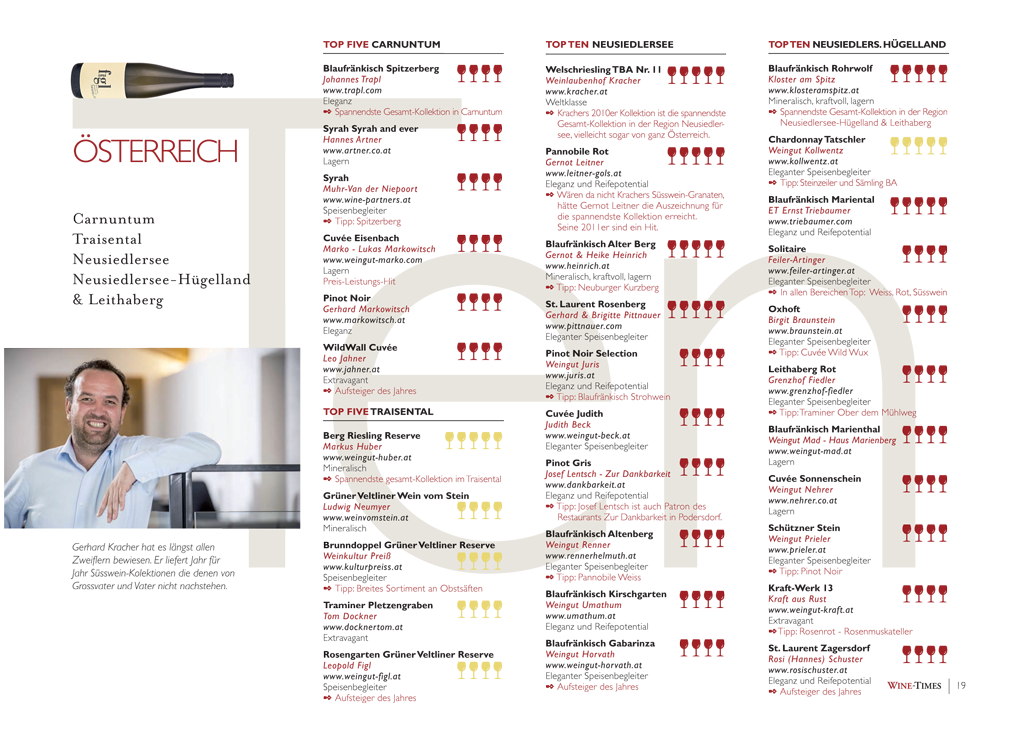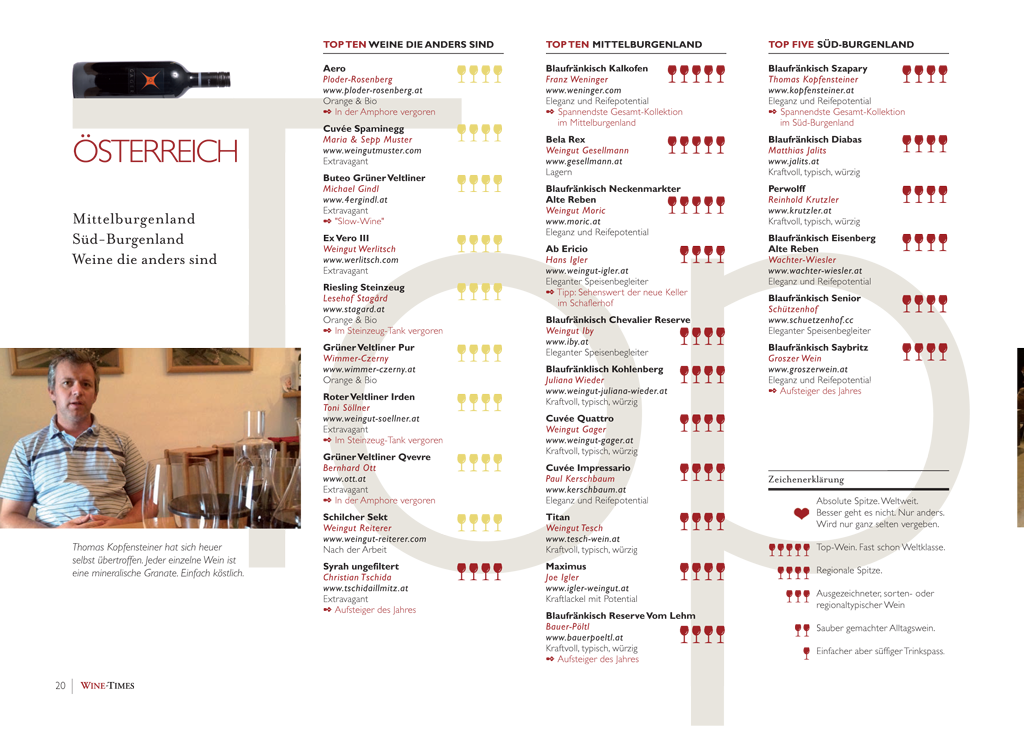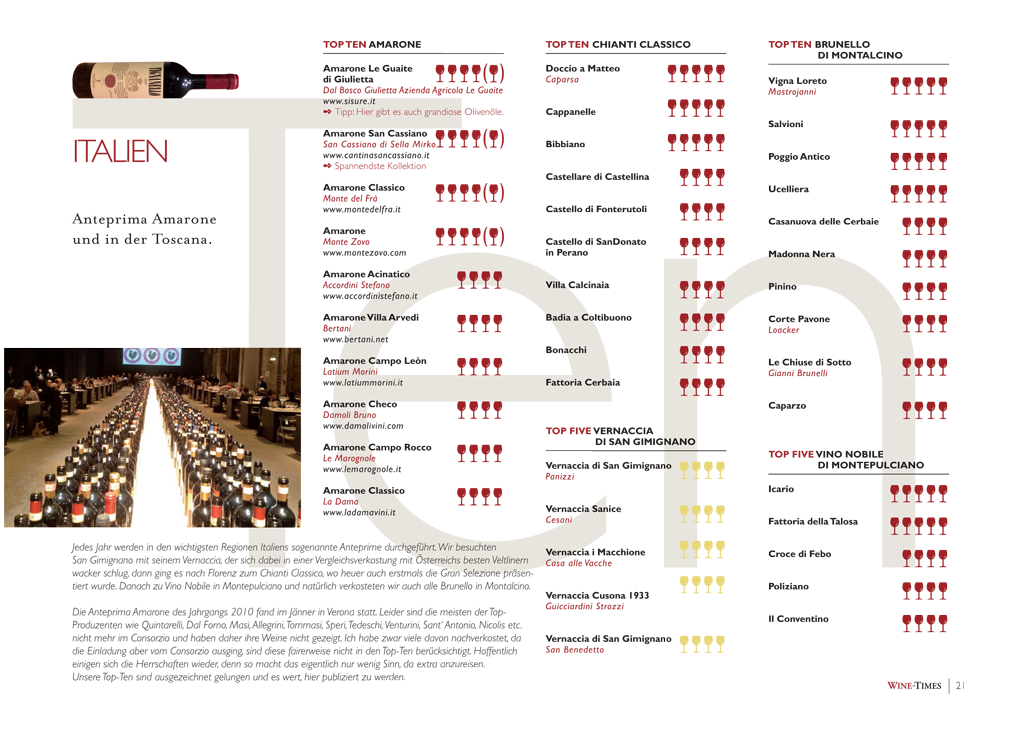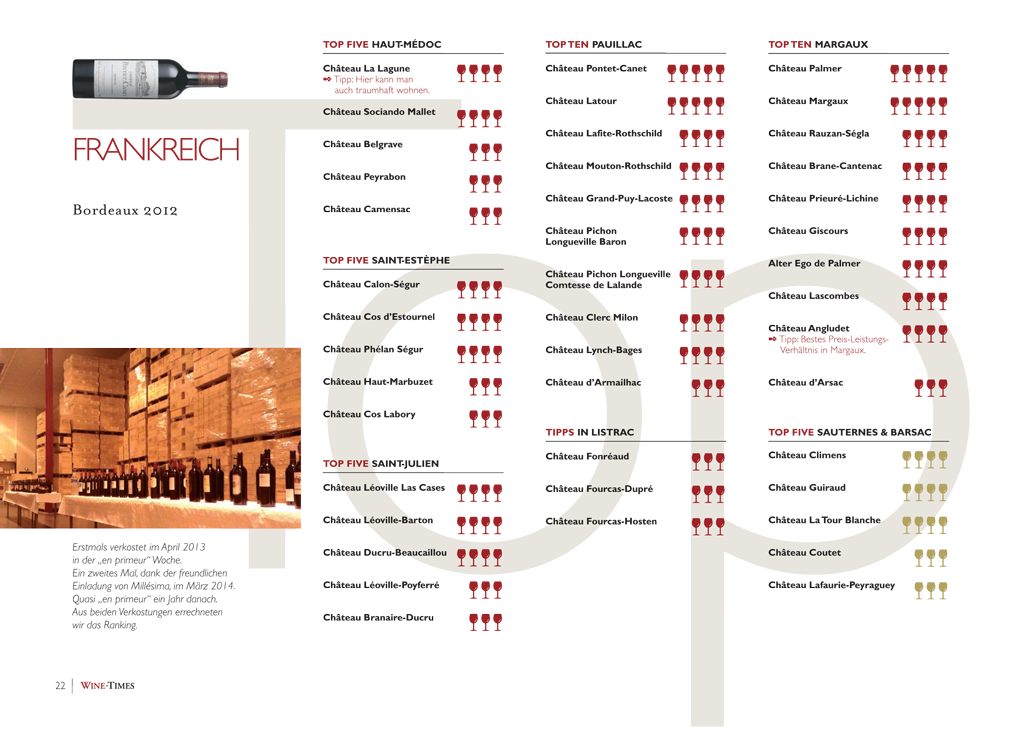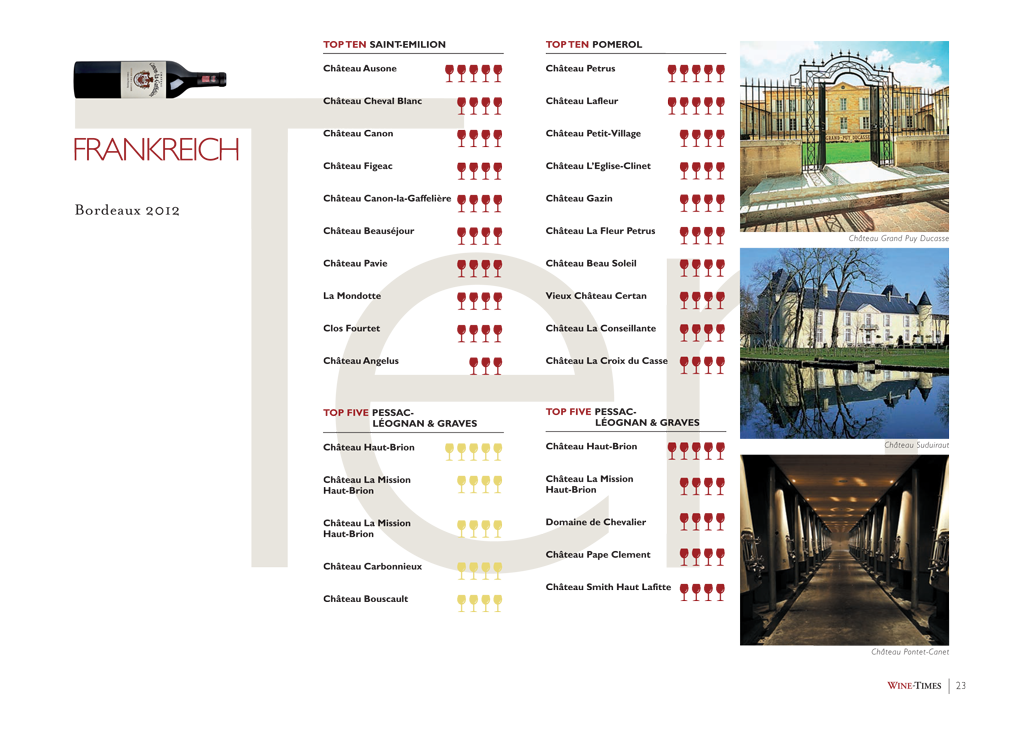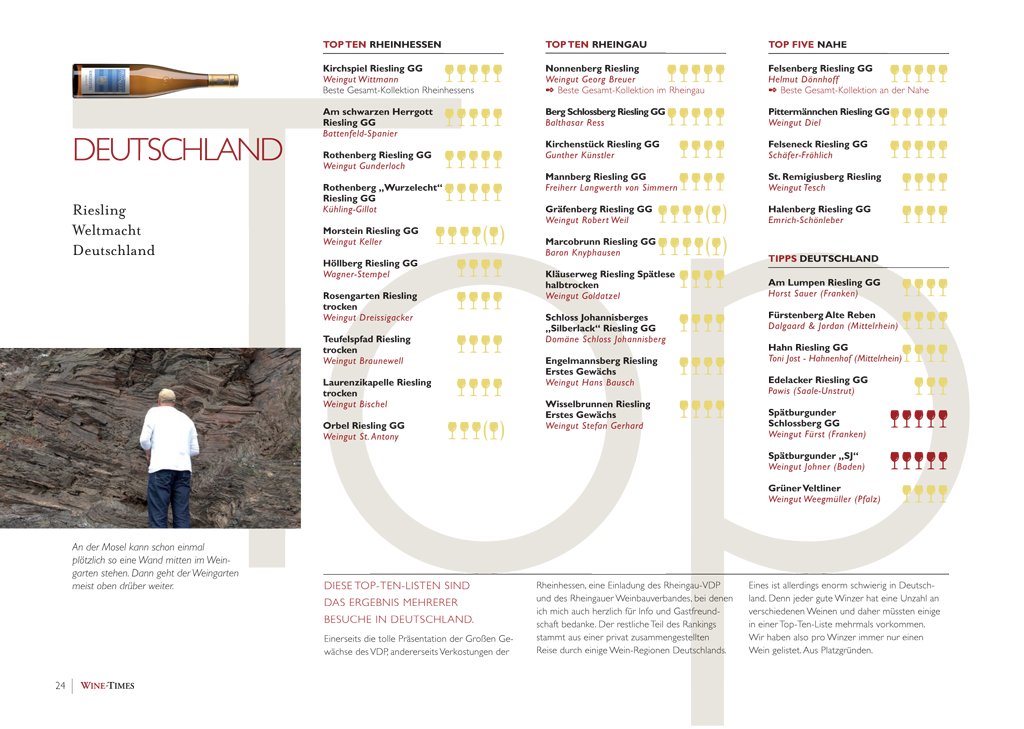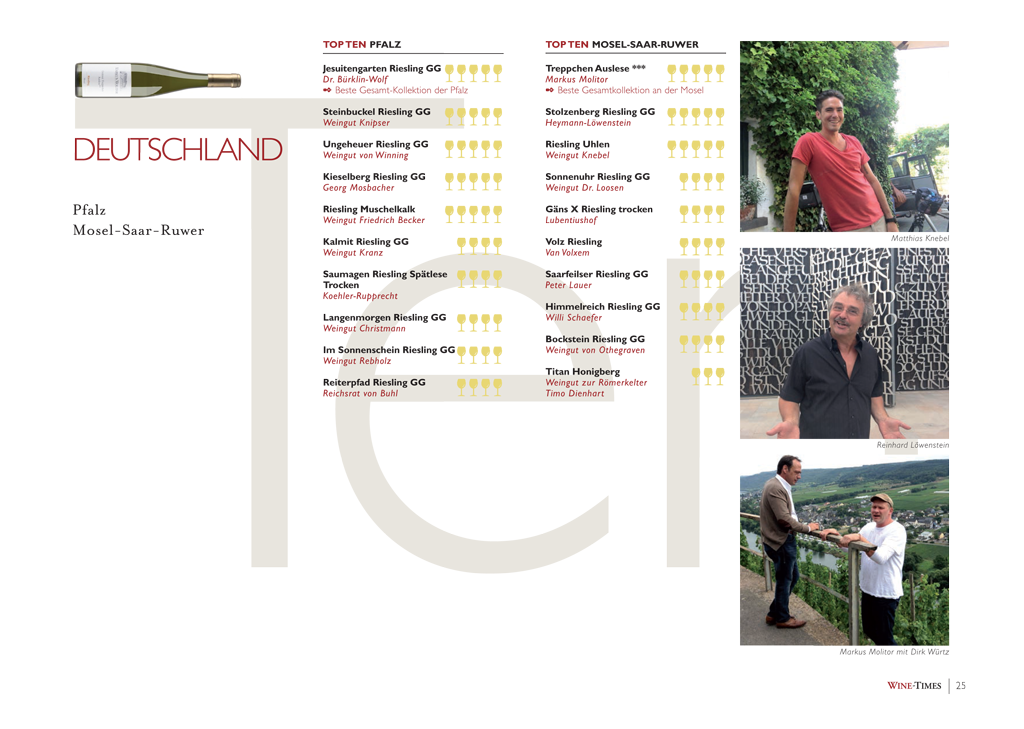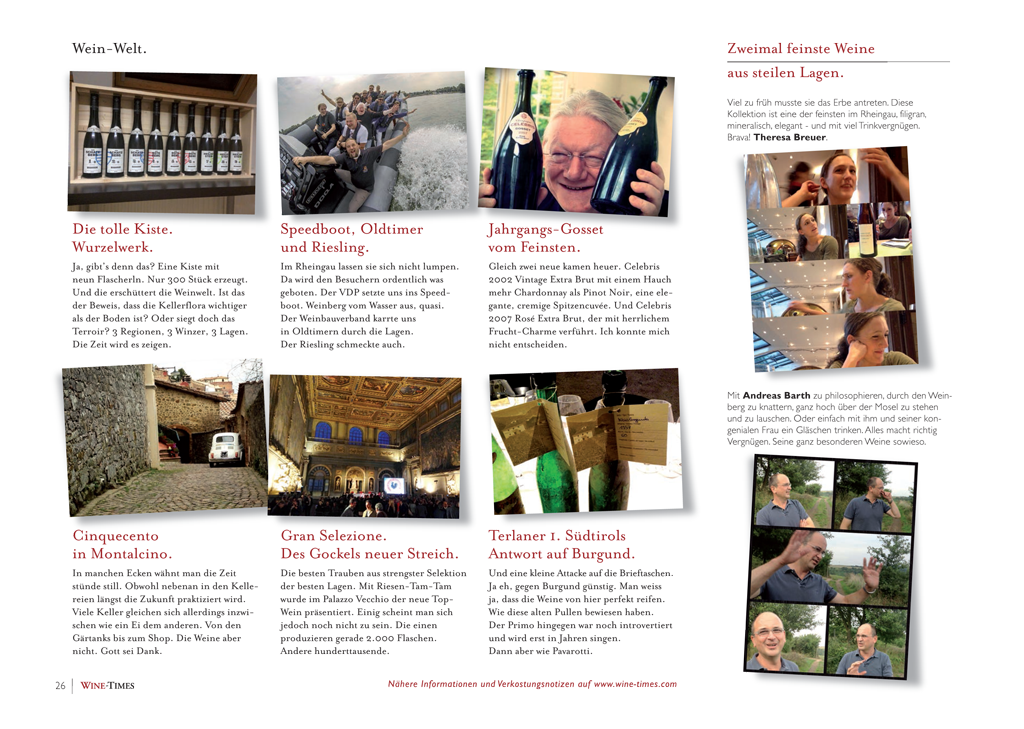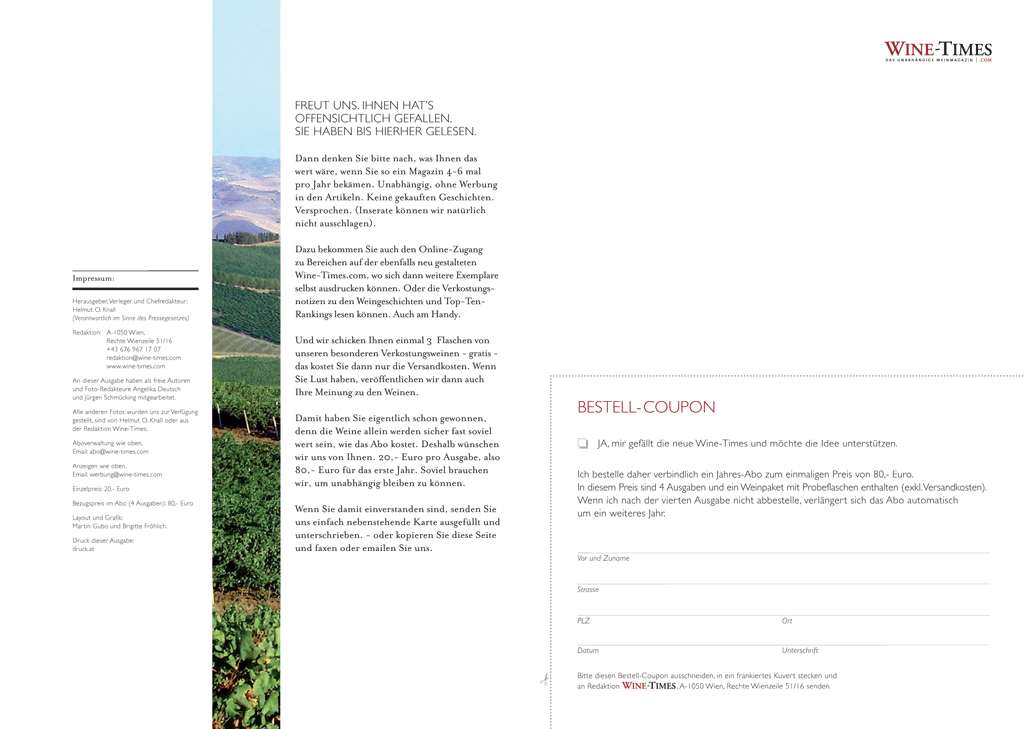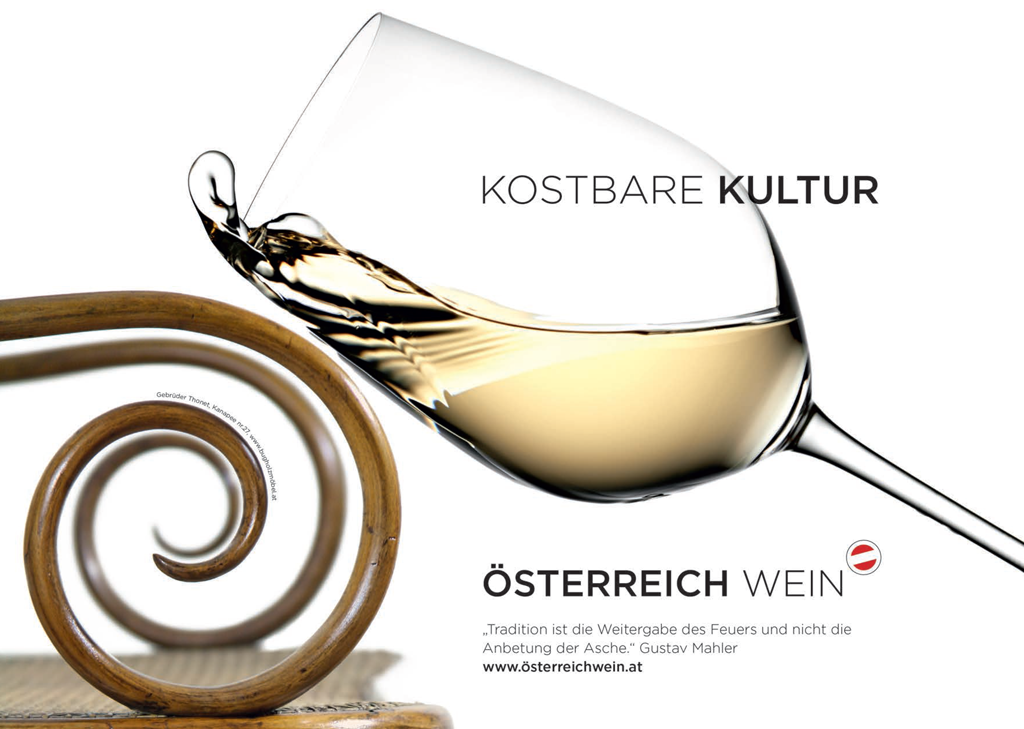Hier geht's zum aktuellen Wine-Guide-Austria in deutscher Sprache, dem ultimativen Nachschlagewerk zum österreichischen Wein.
Small Country. Great Wines.
Austria is the deli in the wine-world.
There is no other country in the wine-world, with a grape variety and wine variety like Austria. This small country – and the main wine-producing areas are only in the eastern and southern part of it – has its own micro-climate.

Loess at Wagram - Perfect soil for Grüner Veltliner... (Foto: ÖWM, Faber)
(Vienna, 2018-02-22, Helmut O. Knall, Wine-Times)
Even in the neighborhood just some hundred kilometers around, it’s not possible to produce such a bunch of different wines of all types. Situated in the middle between the warmer climates like in Hungary or Italy and the cooler climates like in Germany, there is a normal alternation range between warm days and cool nights. Especially along the river Danube. That’s why Austria offers a variety of elegant dry white wines, perfect matured red wines and world famous sweet wines.
But let’s start with a little background information.
In the last 20 years, the small country of Austria developed to a shooting star in the wine-world. All the well known wine-critics like Robert Parker, Jancis Robinson or René Gabriel wrote hymns about wines from Austria. First the incomparable sweet wines, followed by the great dry white-wines to the now boomig “red wine wonder”.
How did it come? After the Second World War, all over Europe was the need to produce lots of wine, not quality. Logical, one had to rebuild the damaged courtyards, to feed the family. And also logical no one had the money to buy expensive wines. This went on to 1960ies and 1970ies. The vineyards were replanted to the “Lenz Moser high crop”, to get high quantity with machine fitting space between two rows. A bottle with 0,75 l was filled with same wine like the usual 2 l bottle, just for the Christmas-presents of companies or for the tombola at the ball.
But times are changing.
The next generation got perfect education at the wine-colleges (Austria is famous for these schools), they got the possibility to practice in the best vineries from Bordeaux to News Zealand, from Germany to California. This international knowledge was brought in – step by step – to Austrian vineries. Again all the vineyards were restructured and replanted. Modern technology became standard in the cellars with spotless clean steeltanks and Barriques. Yield restriction and modern vinification had the target quality instead of quantity. Because there would be no chance for a small country to fight against big wine-producing nations by price. Small but powerful was – and still is – the motto.
And the young generation managed it, to win prices in competitions worldwide. Especially the dry white wines got famous from the United States to Asia. Maybe this is the reason for still 60% of all of the Austrian wines are white.
The wine-growing regions.
90 per cent of all wines come from a circle of one hour drive around Vienna. Only 7 per cent are produced in the southern part called “Steiermark” (English: Styria), which is also only 2 hours drive from Vienna. The rest of 3% is splittered in not well known areas to the west.
Even in the neighborhood just some hundred kilometers around, it’s not possible to produce such a bunch of different wines of all types. Situated in the middle between the warmer climates like in Hungary or Italy and the cooler climates like in Germany, there is a normal alternation range between warm days and cool nights. Especially along the river Danube. That’s why Austria offers a variety of elegant dry white wines, perfect matured red wines and world famous sweet wines.
But let’s start with a little background information.
In the last 20 years, the small country of Austria developed to a shooting star in the wine-world. All the well known wine-critics like Robert Parker, Jancis Robinson or René Gabriel wrote hymns about wines from Austria. First the incomparable sweet wines, followed by the great dry white-wines to the now boomig “red wine wonder”.
How did it come? After the Second World War, all over Europe was the need to produce lots of wine, not quality. Logical, one had to rebuild the damaged courtyards, to feed the family. And also logical no one had the money to buy expensive wines. This went on to 1960ies and 1970ies. The vineyards were replanted to the “Lenz Moser high crop”, to get high quantity with machine fitting space between two rows. A bottle with 0,75 l was filled with same wine like the usual 2 l bottle, just for the Christmas-presents of companies or for the tombola at the ball.
But times are changing.
The next generation got perfect education at the wine-colleges (Austria is famous for these schools), they got the possibility to practice in the best vineries from Bordeaux to News Zealand, from Germany to California. This international knowledge was brought in – step by step – to Austrian vineries. Again all the vineyards were restructured and replanted. Modern technology became standard in the cellars with spotless clean steeltanks and Barriques. Yield restriction and modern vinification had the target quality instead of quantity. Because there would be no chance for a small country to fight against big wine-producing nations by price. Small but powerful was – and still is – the motto.
And the young generation managed it, to win prices in competitions worldwide. Especially the dry white wines got famous from the United States to Asia. Maybe this is the reason for still 60% of all of the Austrian wines are white.
The wine-growing regions.
90 per cent of all wines come from a circle of one hour drive around Vienna. Only 7 per cent are produced in the southern part called “Steiermark” (English: Styria), which is also only 2 hours drive from Vienna. The rest of 3% is splittered in not well known areas to the west.
Let’s start with Vienna.

Vineyards on the hills of Vienna. (Foto: ÖWM, Faber)
There are nearly 700 hectares of wine within the city-limit. Working in the vineyards with a spectacular view. And Viennese Wine is booming. Mainly white wines, like Riesling, Pinot Blanc and Grüner Veltliner, but also red varieties like Zweigelt, Cabernet Sauvignon and Syrah are available. The specialty is called “Gemischter Satz”, which means, in the vineyards are up to 10 different grape varieties mixed-planted. From early ripening varieties to lates, from neutral grapes with fresh acidity to tasty, but less “sour” ones. All are harvested and pressed together. What was in former times security to have acceptable wines in good and bad years, is now the specialty of the city. One can drink these wines at the traditional “Wiener Heurigen”. It’s something like a Wine-Restaurant at the winery.
Along the Danube to the west we have Wagram, Kremstal, Traisental, Kamptal and the most famous white-wine-region: Wachau.
Dominated by more than 60 % Grüner Veltliner, accompanied by Riesling, Pinot Blanc, Sauvignon Blanc and some autochthon varieties like Roter Veltliner or Neuburger. The special terroir from loess and primary-rocks let the wines develop in very fine structured body with a lot of minerality.
Up to the north is the largest wine-region, called “Weinviertel” (Quarter of Wine).
The name is program. Nearly 1/3 of all Austrian wines belong there, 16.650 hectares out of 51.000 all over the country. And nearly 70 % is Grüner Veltliner. Here labeled as “Weinviertel DAC” which is the first quality controlled denomination guaranty. A real dry, spicy – “peppery” – white, which fits perfect to the typical Viennese kitchen and to spicy Asian food.
To the east, just twenty minutes by car, there is the region of Carnuntum.
Like the name let guess, it was the center of the Romans. A small region with brilliant, mouth filling whites from Grüner Veltliner and Chardonnay, and, in the last decade more and more well known for sexy mouthfilling red wine specialities.
Along the Danube to the west we have Wagram, Kremstal, Traisental, Kamptal and the most famous white-wine-region: Wachau.
Dominated by more than 60 % Grüner Veltliner, accompanied by Riesling, Pinot Blanc, Sauvignon Blanc and some autochthon varieties like Roter Veltliner or Neuburger. The special terroir from loess and primary-rocks let the wines develop in very fine structured body with a lot of minerality.
Up to the north is the largest wine-region, called “Weinviertel” (Quarter of Wine).
The name is program. Nearly 1/3 of all Austrian wines belong there, 16.650 hectares out of 51.000 all over the country. And nearly 70 % is Grüner Veltliner. Here labeled as “Weinviertel DAC” which is the first quality controlled denomination guaranty. A real dry, spicy – “peppery” – white, which fits perfect to the typical Viennese kitchen and to spicy Asian food.
To the east, just twenty minutes by car, there is the region of Carnuntum.
Like the name let guess, it was the center of the Romans. A small region with brilliant, mouth filling whites from Grüner Veltliner and Chardonnay, and, in the last decade more and more well known for sexy mouthfilling red wine specialities.
Around the lake.

Special climate for sweet wines around the lake in Burgenland. (Foto: ÖWM, Lukan)
Another twenty minutes and we arrive the area of the world’s largest steppe lake called “Neusiedler See”. Around this lake there are four wine regions: Neusiedlersee-Hügelland, with brilliant mineralic whites and rangy reds at the hilly sites of “Leithaberg” and some of the famous sweet-wine specialities from the small city of Rust, called “Ruster Ausbruch”.
The region Neusiedlersee is famous for the best red Cuvées from Zweigelt, Merlot, Cabernet Sauvignon and some Syrah’s, as well for the world-famous sweet wines from Kracher, Lang, Tschida, Oppitz & Co.
The third Destination is called Mittelburgenland. Near the Hungarian border there is an island for astonishing red wines from an autochthon grape-variety: Blaufränkisch, which brings real great wines, which won in some blind-tastings against wines for ten times higher prices (Bordeaux for example). This is the second region with a denomination control labeled as “Mittelburgenland DAC”.
And last, but not least we have Süd-Burgenland. A real beautiful landscape, the home of a unique vinous form made from various hybrids and in a special area around the “Eisenberg” we find very mineralic and spicy reds. Michael Broadbent once said: “maybe the best red-wine-region, but to small”.
Let’s go south.
Just outside the Viennese borders we find a hilly region called Thermenregion, where we can find two grape varieties, that grow nowhere else in the world. Zierfandler and Rotgipfler, who fit very well to chicken or veal-cutlet. The more south we get the more we find elegant red wines, especially from Pinot Noir, in this very small region.
The region Neusiedlersee is famous for the best red Cuvées from Zweigelt, Merlot, Cabernet Sauvignon and some Syrah’s, as well for the world-famous sweet wines from Kracher, Lang, Tschida, Oppitz & Co.
The third Destination is called Mittelburgenland. Near the Hungarian border there is an island for astonishing red wines from an autochthon grape-variety: Blaufränkisch, which brings real great wines, which won in some blind-tastings against wines for ten times higher prices (Bordeaux for example). This is the second region with a denomination control labeled as “Mittelburgenland DAC”.
And last, but not least we have Süd-Burgenland. A real beautiful landscape, the home of a unique vinous form made from various hybrids and in a special area around the “Eisenberg” we find very mineralic and spicy reds. Michael Broadbent once said: “maybe the best red-wine-region, but to small”.
Let’s go south.
Just outside the Viennese borders we find a hilly region called Thermenregion, where we can find two grape varieties, that grow nowhere else in the world. Zierfandler and Rotgipfler, who fit very well to chicken or veal-cutlet. The more south we get the more we find elegant red wines, especially from Pinot Noir, in this very small region.
Two hours later.

The breathtaking view in South-Styria. (Foto: ÖWM, Stöcher)
Here, sometimes really along the Slovenian border it’s pretty different. In Steiermark (Styria) is the home of international highly rated Sauvignon Blanc and Chardonnays (here called “Morillon”). The hilly soils from the former ocean and the micro-climate with pretty hot days and very cool nights bring very mineralic and fruity whites. A lot of hills made some wine-critics romanticize of the “Austrian Toscana”, but for me it's much prettier, because all the hills stay green during summer...
Beside the well known Sauvignons and Chardonnays here are some grape-varieties which are mostly consumed in the little “Buschenschank” (small pubs at the wineries, where you can eat homemade ham and some cold local specialities and drink the wines from the winery).
In the western part it is a Rosé called “Schilcher”, in the South it’s “Welschriesling” and in the Southeast on volcanic soils grows a very spicy Traminer.
Why “Deli” ?
In the beginning we said, Austria is the Deli of the wine-world. Let’s explain that. With the multitude of different micro-climates and terroirs, it would be possible to cultivate hundreds of different grape varieties.
Even if the leading grape variety is Grüner Veltliner with more than 35%, there are more than thirty different grape varieties cultivated in Austria.
Two-thirds are white grapes. From the international varieties like Chardonnay, Pinot Blanc and Pinot Gris to Riesling and Sauvignon Blanc to the regional varieties like Welschriesling, Müller-Thurgau, Neuburger, Muskateller, Traminer, Zierfandler, Rotgipfler and some others.
In the last ten years the reds from Austria are booming. Most of them are single variety wines or cuvees out of the two leading autochthon varieties Zweigelt and Blaufränkisch. The rest is Pinot Noir, St. Laurent, Blauer Portugieser, Cabernet Sauvignon, Merlot, Syrah and Blauer Wildbacher who is regional speciality in the western part of styria, where they produce a crispy rosé called “Schilcher”.
Beside the well known Sauvignons and Chardonnays here are some grape-varieties which are mostly consumed in the little “Buschenschank” (small pubs at the wineries, where you can eat homemade ham and some cold local specialities and drink the wines from the winery).
In the western part it is a Rosé called “Schilcher”, in the South it’s “Welschriesling” and in the Southeast on volcanic soils grows a very spicy Traminer.
Why “Deli” ?
In the beginning we said, Austria is the Deli of the wine-world. Let’s explain that. With the multitude of different micro-climates and terroirs, it would be possible to cultivate hundreds of different grape varieties.
Even if the leading grape variety is Grüner Veltliner with more than 35%, there are more than thirty different grape varieties cultivated in Austria.
Two-thirds are white grapes. From the international varieties like Chardonnay, Pinot Blanc and Pinot Gris to Riesling and Sauvignon Blanc to the regional varieties like Welschriesling, Müller-Thurgau, Neuburger, Muskateller, Traminer, Zierfandler, Rotgipfler and some others.
In the last ten years the reds from Austria are booming. Most of them are single variety wines or cuvees out of the two leading autochthon varieties Zweigelt and Blaufränkisch. The rest is Pinot Noir, St. Laurent, Blauer Portugieser, Cabernet Sauvignon, Merlot, Syrah and Blauer Wildbacher who is regional speciality in the western part of styria, where they produce a crispy rosé called “Schilcher”.
The “Gruner”, the peppery speciality.

Vineyards around castle Kapfenstein in Styria.
Probably, Grüner Veltliner ist the grape variety that enables the broadest spectrum of wine-styles. From crispy light about spicy mineralic to burgundy style mouthfilling wines. Depending on the different sites and terroir you will find the different styles.
In the regions Weinviertel and Vienna dominates the slight but racy and fruity style with a touch of white pepper. Kamptal and Wagram offer fullbodied wines grown on loess, with lets say “earthy” minerality. And Kremstal, Traisental and especially Wachau, with their primary rock soils, give the possibility to produce deep mineralic wines with elegance and structure. Some of them won against famous burgundy wines in blind-tastings.
In the regions Weinviertel and Vienna dominates the slight but racy and fruity style with a touch of white pepper. Kamptal and Wagram offer fullbodied wines grown on loess, with lets say “earthy” minerality. And Kremstal, Traisental and especially Wachau, with their primary rock soils, give the possibility to produce deep mineralic wines with elegance and structure. Some of them won against famous burgundy wines in blind-tastings.
Some well known producers in the regions.

Famous sites like Achleiten all along the Danube in Wachau. (Foto: ÖWM, Semrad)
Wachau.
Emmerich Knoll, F.X. Pichler, Leo Alzinger, Prager, Johann Donabaum, Freie Weingärtner Wachau, Josef Jamek, Rudi Pichler, Johann Schmelz, Rainer Wöss, Karl Lagler, Franz Hirtzberger, Nikolaihof, Sigl,
Kremstal.
Wolfgang Aigner, Walter Buchegger, Josef Dockner, Mantlerhof, Hermann Moser, Sepp Moser, Lenz Moser, Martin Nigl, Franz Proidl, Salomon-Undhof, Weingut Stadt Krems, Weingut Stift Göttweig, Geyerhof, Mayer-Vorspannhof, Petra Unger.
Kamptal.
Josef Aichinger, Allram, Kurt Angerer, Willi Bründlmayer, Birgit Eichinger, Schloss Gobelsburg, Ludwig Hiedler, Hannes Hirsch, Sonnhof-Jurtschitsch, Fred Loimer, Rupert Summerer, Steininger, Hans Topf.
Traisental.
Markus Huber, Familie Holzer, Ludwig Neumayer, Pernikl, Preiss.
Wagram.
Anton Bauer, Josef Bauer, Leopold Blauensteiner, Josef Ehmoser, Karl Fritsch, Stift Klosterneuburg, Franz Leth, Franz-Anton Mayer, Bernhard Ott, Toni Soellner, Wimmer-Czerny.
Weinviertel.
Pollerhof, Graf Hardegg, Malteser Ritterorden, Pleil, Schwarzböck, Prechtl, Setzer, Diem, Minkowitsch, Zillinger, Zuschmann, Ebner-Ebenauer, Pfaffl, Taubenschuss, Weinrieder, Zull.
Wien.
Rainer Christ, Michael Edlmoser, Hengl-Haselbrunner, Hajszan, Mayer am Pfarrplatz, Rotes Haus, Fritz Wieninger, Zahel, Jutta Ambrositsch.
Carnuntum.
Hannes Artner, Böheim, Glatzer, Grassl, Marko, Markowitsch, Netzl, Pitnauer, Taferner.
Thermenregion.
Alphart, Aumann, Biegler, Fischer, Toni Hartl, Johanneshof-Reinisch, Krug, Schellmann, Spaetrot, Stadlmann, Zierer.
Neusiedlersee.
Paul Achs, Werner Achs, Judith Beck, Goldenits, Gsellmann, Gernot Heinrich, Schloss Halbturn, Martin Haider, Hillinger, Juris, Kracher, Helmut Lang, Leitner, Lentsch, Nittnaus, Pittnauer, Pöckl, Renner, Schwarz, Tschida, Umathum, Velich, Zantho.
Neusiedlersee-Hügelland.
Braunstein, Feiler-Artinger, Fiedler, Fink, Giefing, Kollwentz, Leberl, Prieler, Schandl, Schönberger, Heidi Schröck, Rosi Schuster, Tinhof, Triebaumer, Wenzel.
Mittelburgenland.
Arachon, Bauer-Pöltl, In Signo Leonis – Bayer, Gager, Gesellmann, Johann Heinrich, Iby, Iby-Lehrner, Igler, Kerschbaum, Kirnbauer, Lang, Moric, Pfneisl, Reumann, Strehn, Szemes, Tesch, Weninger, Wieder.
Süd-Burgenland.
Jalits, Kopfensteiner, Krutzler, Uwe Schiefer, Schützenhof, Vinum-Ferreum, Wachter-Wiesler, Weber.
Steiermark.
Gross, Harkamp, Jaunegg, Lackner-Tinnacher, Polz, Sabathi, Sattlerhof, Skoff, Tement, Tscheppe, Wohlmuth, Neumeister, Ploder-Rosenberg, Winkler-Hermaden, Domäne Müller, Reiterer.
Emmerich Knoll, F.X. Pichler, Leo Alzinger, Prager, Johann Donabaum, Freie Weingärtner Wachau, Josef Jamek, Rudi Pichler, Johann Schmelz, Rainer Wöss, Karl Lagler, Franz Hirtzberger, Nikolaihof, Sigl,
Kremstal.
Wolfgang Aigner, Walter Buchegger, Josef Dockner, Mantlerhof, Hermann Moser, Sepp Moser, Lenz Moser, Martin Nigl, Franz Proidl, Salomon-Undhof, Weingut Stadt Krems, Weingut Stift Göttweig, Geyerhof, Mayer-Vorspannhof, Petra Unger.
Kamptal.
Josef Aichinger, Allram, Kurt Angerer, Willi Bründlmayer, Birgit Eichinger, Schloss Gobelsburg, Ludwig Hiedler, Hannes Hirsch, Sonnhof-Jurtschitsch, Fred Loimer, Rupert Summerer, Steininger, Hans Topf.
Traisental.
Markus Huber, Familie Holzer, Ludwig Neumayer, Pernikl, Preiss.
Wagram.
Anton Bauer, Josef Bauer, Leopold Blauensteiner, Josef Ehmoser, Karl Fritsch, Stift Klosterneuburg, Franz Leth, Franz-Anton Mayer, Bernhard Ott, Toni Soellner, Wimmer-Czerny.
Weinviertel.
Pollerhof, Graf Hardegg, Malteser Ritterorden, Pleil, Schwarzböck, Prechtl, Setzer, Diem, Minkowitsch, Zillinger, Zuschmann, Ebner-Ebenauer, Pfaffl, Taubenschuss, Weinrieder, Zull.
Wien.
Rainer Christ, Michael Edlmoser, Hengl-Haselbrunner, Hajszan, Mayer am Pfarrplatz, Rotes Haus, Fritz Wieninger, Zahel, Jutta Ambrositsch.
Carnuntum.
Hannes Artner, Böheim, Glatzer, Grassl, Marko, Markowitsch, Netzl, Pitnauer, Taferner.
Thermenregion.
Alphart, Aumann, Biegler, Fischer, Toni Hartl, Johanneshof-Reinisch, Krug, Schellmann, Spaetrot, Stadlmann, Zierer.
Neusiedlersee.
Paul Achs, Werner Achs, Judith Beck, Goldenits, Gsellmann, Gernot Heinrich, Schloss Halbturn, Martin Haider, Hillinger, Juris, Kracher, Helmut Lang, Leitner, Lentsch, Nittnaus, Pittnauer, Pöckl, Renner, Schwarz, Tschida, Umathum, Velich, Zantho.
Neusiedlersee-Hügelland.
Braunstein, Feiler-Artinger, Fiedler, Fink, Giefing, Kollwentz, Leberl, Prieler, Schandl, Schönberger, Heidi Schröck, Rosi Schuster, Tinhof, Triebaumer, Wenzel.
Mittelburgenland.
Arachon, Bauer-Pöltl, In Signo Leonis – Bayer, Gager, Gesellmann, Johann Heinrich, Iby, Iby-Lehrner, Igler, Kerschbaum, Kirnbauer, Lang, Moric, Pfneisl, Reumann, Strehn, Szemes, Tesch, Weninger, Wieder.
Süd-Burgenland.
Jalits, Kopfensteiner, Krutzler, Uwe Schiefer, Schützenhof, Vinum-Ferreum, Wachter-Wiesler, Weber.
Steiermark.
Gross, Harkamp, Jaunegg, Lackner-Tinnacher, Polz, Sabathi, Sattlerhof, Skoff, Tement, Tscheppe, Wohlmuth, Neumeister, Ploder-Rosenberg, Winkler-Hermaden, Domäne Müller, Reiterer.
© by Weinspitz_Helmut_Knall
last modified: 2018-04-06 23:31:06
last modified: 2018-04-06 23:31:06







